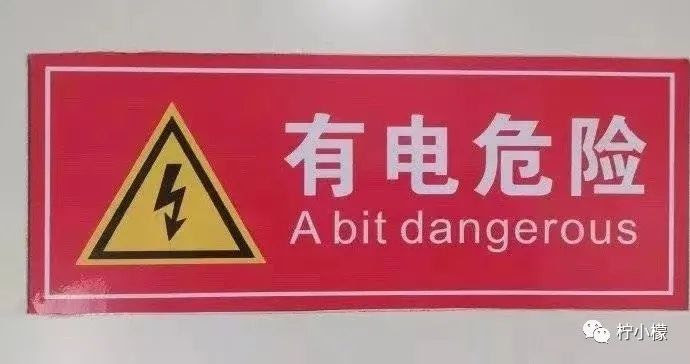Omnibus Chinglish, part 1
« previous post | next post »
Fantastic collection of Chinglish examples from WeChat.
There are 18 examples all together. I've already done 2 or 3 of them (see under "Selected readings" below), and a couple of them are not so great. That leaves around a dozen that are previously unknown and quite hilarious. I'll do them in two or three batches.
1.
sāzi
撒子
"what" (taken directly from Google Translate)
I believe that the underlying topolectal expression is for Northeastern sazi ("what"); also occurs in Sichuanese. The confusion arises here because it sounds like topolectal "sazi / sāzi" ("what") and the character for this deep-fried noodle snack looks like the ad hoc character for the topolectal expression: 撒, cf. 馓.
Sangza (Uighur: ساڭزا, Саңза; simplified Chinese: 馓子; traditional Chinese: 饊子; pinyin: sǎn zi; Zhuyin Fuhao: ㄙㄢˇ ·ㄗ, IPA: [sàn.tsi], Xiao'erjing: صًا ذِ) is a popular snack in north of China, consisting of deep-fried noodles in a twisted pyramid shape. The snack is made by pulling wheat flour dough into thin ropes, which are deep-fried. Bunches of the ropes are then shaped into rings, which are stacked into a pyramid.
Sangza is also eaten in other areas of China where the Hui minority live.
(source)
2.
yǒu diàn wéixiǎn
有电危险
"Danger! Electricity!"
misread as the near homophone:
yǒudiǎn wéixiǎn
有点危险
"bit dangerous" (taken directly from Google Translate)
3.
wèi kāikǒu de huājiǎ qǐng wù shí
未开口的花甲请勿食
"Please do not eat the clams that are unopened"
huājiǎ 花甲 can mean a full cycle of 60, hence a sexagenarian, but here it should be interpreted as a synonym, homophone, or variant orthography of huāgé 花蛤, a type of clam (Ruditapes philippinarum). This is amusing without getting into the linguistic subtleties, which I'll delve into more fully in the following paragraphs, because why should anyone think of eating a closed, hard shell.
Phonological note: The Cantonese pronunciation of 花甲 (MSM huājiǎ) is faa1 gaap3, Hakka is fâ-kap, Minnan is hoa-kah / hoe-kah.
Grammatical note: The initial negative of the Chinese is ignored in the English.
A native speaker of Cantonese from Hong Kong gave a good explanation: usually the name 花蛤 appears in seafood markets / restaurants / tea shops 茶餐廳 (see below), where those who would write the name on a menu or order slip might be fishermen (who would tend to be less educated). They are less likely to know how to write the correct 蛤 (Cant. gap3, gaap3), so they just use the homophone 甲 (Cant. gaap3). Or maybe they do know the word, but simply want to write the simpler form.
He gave another classic example of shorthand in HK for 茶餐廳 (MSM chácāntīng / Cant. caa4 caan1 teng1) (I have written about this phenomenon — restaurant shorthand and Hong Kong tea shops, etc. [see "Selected readings" below for some examples]): people write "冬OT" for 凍檸茶 for iced lemon tea, because O=零 and sounds similar to 檸 (too complicated to write), T=tea. (VHM: The phonological and morphological / orthographical complexities are too subtle to go into in greater detail here. Suffice it to say that these are the kinds of language games that Cantonese love to play.)
Selected readings
- "Don't joke the monkeys" (10/20/11) — see the first item for another interpretation of sāzi 撒子
- "Collect Fees Documents at Miss Hot Cafe" (11/28/14)
- "Remarkable Name of a Hong Kong Restaurant" (11/12/19) — with extensive bibliography
- "Hong Kong-specific characters and shorthand" (3/15/15), with links to relevant websites for restaurant shorthand characters
- "General Tso's chikin" (6/11/13), especially in the comments
- "Chinese restaurant shorthand" (9/22/16)
- "Chinese restaurant shorthand, part 2 " (11/30/16)
- "Chinese restaurant shorthand, part 3 " (2/25/17)
- "Chinese restaurant shorthand, part 4" (4/21/17)
- "Chinese restaurant shorthand, part 5" (5/15/19)
- "Chinese restaurant shorthand, part 6" (6/17/19)
- "Big WHAT hall" (12/1/15)
- "Reclamation of a wasteland by an army unit" (2/11/19)
- "Slip carefully" (5/6/14) — extensively covered on LL; this is just one iteration
- "New Singaporean and Hong Kong terms in the OED" (5/12/16) — search under "milk tea" and "yum cha"; there are many other posts about tea on LL, including bubble tea, cactus tea, etc.; I thought I wrote about tea prepared in silk stockings, but apparently never did so.
[h.t. Francis Miller; thanks to Zihan Guo]



Hwa SH said,
August 29, 2022 @ 5:22 pm
Clams should open when cooked. If they don't it means they've gone bad. People who aren't familiar with seafood Bay not know this, hence the advice.
Hwa SH said,
August 29, 2022 @ 5:23 pm
Sorry typo – that should've been "may not know this" not "Bay not". Nothing to do with Old Bay seasoning even though we're on the topic of seafood.
Peter Taylor said,
August 30, 2022 @ 4:46 am
@Hwa SH, the reason for the sign is that the person who commissioned it believed what you say, but it's not actually true. It seems to have been invented by the author of a cookbook in the 1970s; see this article for more background and modern research on bivalves.
Terry K. said,
August 30, 2022 @ 7:58 am
Well, it's still useful, here, to know about the advice, even if it's not actually true.
Ben said,
September 11, 2022 @ 1:38 pm
Isn't the initial 未wèi in the third picture conveyed by the negative form "UNopened"?